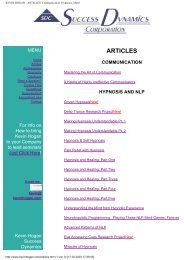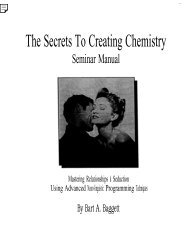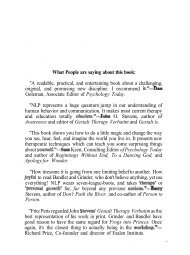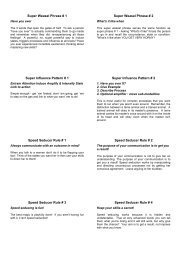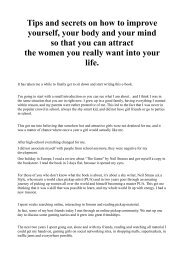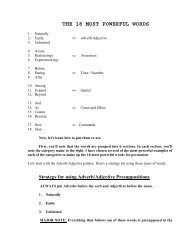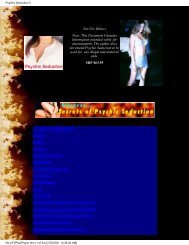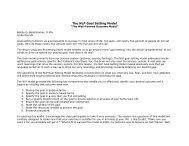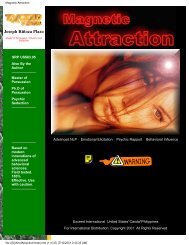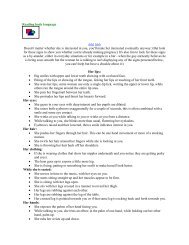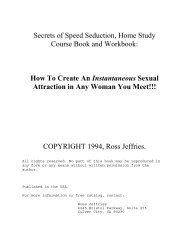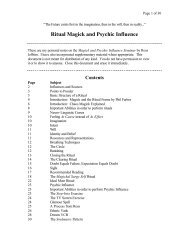A Pragmatic Guide To Communication & Change.pdf - NLP Info Centre
A Pragmatic Guide To Communication & Change.pdf - NLP Info Centre
A Pragmatic Guide To Communication & Change.pdf - NLP Info Centre
- No tags were found...
You also want an ePaper? Increase the reach of your titles
YUMPU automatically turns print PDFs into web optimized ePapers that Google loves.
..~ 1I<br />
One of the ways that Sharon was able to be such a good reader was her ability to keep<br />
noises and external visual stimuli from distracting her. She had learned to systematically<br />
delete from her awareness anything that would detract from her ability to concentrate on<br />
the book she was reading. This can be a very productive utilization of the process of<br />
deletion.<br />
In the years following her traumatic encounter, Sharon also systematically deleted from<br />
her awareness the positive, normal responses of men who became genuinely interested in<br />
her. Her "selective attention" only allowed her to be aware of the things they did to "take<br />
advantage" of her. Because her model of the world did not include the possibility of<br />
warm, kind, and honest attention between men and women, she was not aware of these<br />
qualities when they were present in a male admirer. Without this awareness, no healthy<br />
relationship could develop.<br />
Again, operating without conscious awareness, deletion can assist us by focusing our<br />
attention when necessary, as in the example of Sharon's reading. However, the same<br />
process can often be the major source of a person's emotional distress. It can create<br />
limitations on our models of the world that prevent us from being able to perceive what<br />
we need in order to achieve our goals.<br />
Selective Attention Is Deletion<br />
R Distortion<br />
The third universal human modeling process forms the basis for most acts of creativity.<br />
Distortion is the process by which we alter our perceptions, changing our experience of<br />
sensory input. Using this process we both create and enjoy works of art, music and<br />
literature. It also makes possible our ability to dream, fantasize, and plan for the future.<br />
By allowing us to manipulate our perceptions of reality, of the word as we sense it or<br />
remember it to be, distortion enables us to create totally unique variables. Some of our<br />
"creations" may even be outside the realm of possibility defined by our model of reality.<br />
But whether it results in a "quantum leap" in our thinking or simply enables us to<br />
"interpret" a Picasso, distortion is an important process in our modeling of the world.<br />
The figure above represents a "visual paradox." Because it presents conflicting<br />
information, the observer finds himself attempting to make sense of an apparent<br />
irrational figure. This distortion occurs because of the capacity of the brain to take<br />
in certain kinds of information, in this case a two-dimensional set of lines, and<br />
transform it into something that is nonexistent: a three-dimensional form.<br />
9<br />
These remarkable model-building processes of generalization, deletion, and distortion,<br />
however, are double-edged. As important as they are to our abilities to learn, think, and<br />
create, these same processes can also create pain and suffering in an individual. How do<br />
these indispensable tools create pain? How do they limit perception and disallow<br />
behavior? How do they become counter-productive to a person's normal living and<br />
growing? They do these things by performing their functions just as they are designed.<br />
The following examples will demonstrate how these processes can work both for and<br />
against the best interests of an individual.<br />
Case Study



